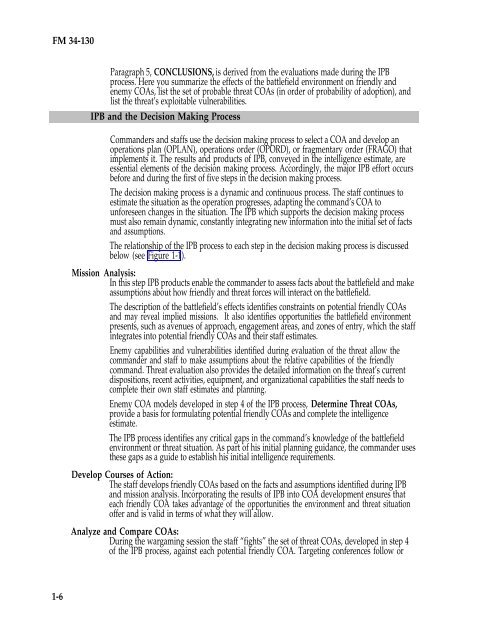Intelligence Preparation of the Battlefield - Federation of American ...
Intelligence Preparation of the Battlefield - Federation of American ...
Intelligence Preparation of the Battlefield - Federation of American ...
You also want an ePaper? Increase the reach of your titles
YUMPU automatically turns print PDFs into web optimized ePapers that Google loves.
FM 34-130<br />
1-6<br />
Paragraph 5, CONCLUSIONS, is derived from <strong>the</strong> evaluations made during <strong>the</strong> IPB<br />
process. Here you summarize <strong>the</strong> effects <strong>of</strong> <strong>the</strong> battlefield environment on friendly and<br />
enemy COAs, list <strong>the</strong> set <strong>of</strong> probable threat COAs (in order <strong>of</strong> probability <strong>of</strong> adoption), and<br />
list <strong>the</strong> threat’s exploitable vulnerabilities.<br />
IPB and <strong>the</strong> Decision Making Process<br />
Commanders and staffs use <strong>the</strong> decision making process to select a COA and develop an<br />
operations plan (OPLAN), operations order (OPORD), or fragmentary order (FRAGO) that<br />
implements it. The results and products <strong>of</strong> IPB, conveyed in <strong>the</strong> intelligence estimate, are<br />
essential elements <strong>of</strong> <strong>the</strong> decision making process. Accordingly, <strong>the</strong> major IPB effort occurs<br />
before and during <strong>the</strong> first <strong>of</strong> five steps in <strong>the</strong> decision making process.<br />
The decision making process is a dynamic and continuous process. The staff continues to<br />
estimate <strong>the</strong> situation as <strong>the</strong> operation progresses, adapting <strong>the</strong> command’s COA to<br />
unforeseen changes in <strong>the</strong> situation. The IPB which supports <strong>the</strong> decision making process<br />
must also remain dynamic, constantly integrating new information into <strong>the</strong> initial set <strong>of</strong> facts<br />
and assumptions.<br />
The relationship <strong>of</strong> <strong>the</strong> IPB process to each step in <strong>the</strong> decision making process is discussed<br />
below (see Figure 1-1).<br />
Mission Analysis:<br />
In this step IPB products enable <strong>the</strong> commander to assess facts about <strong>the</strong> battlefield and make<br />
assumptions about how friendly and threat forces will interact on <strong>the</strong> battlefield.<br />
The description <strong>of</strong> <strong>the</strong> battlefield’s effects identifies constraints on potential friendly COAs<br />
and may reveal implied missions. It also identifies opportunities <strong>the</strong> battlefield environment<br />
presents, such as avenues <strong>of</strong> approach, engagement areas, and zones <strong>of</strong> entry, which <strong>the</strong> staff<br />
integrates into potential friendly COAs and <strong>the</strong>ir staff estimates.<br />
Enemy capabilities and vulnerabilities identified during evaluation <strong>of</strong> <strong>the</strong> threat allow <strong>the</strong><br />
commander and staff to make assumptions about <strong>the</strong> relative capabilities <strong>of</strong> <strong>the</strong> friendly<br />
command. Threat evaluation also provides <strong>the</strong> detailed information on <strong>the</strong> threat’s current<br />
dispositions, recent activities, equipment, and organizational capabilities <strong>the</strong> staff needs to<br />
complete <strong>the</strong>ir own staff estimates and planning.<br />
Enemy COA models developed in step 4 <strong>of</strong> <strong>the</strong> IPB process, Determine Threat COAs,<br />
provide a basis for formulating potential friendly COAs and complete <strong>the</strong> intelligence<br />
estimate.<br />
The IPB process identifies any critical gaps in <strong>the</strong> command’s knowledge <strong>of</strong> <strong>the</strong> battlefield<br />
environment or threat situation. As part <strong>of</strong> his initial planning guidance, <strong>the</strong> commander uses<br />
<strong>the</strong>se gaps as a guide to establish his initial intelligence requirements.<br />
Develop Courses <strong>of</strong> Action:<br />
The staff develops friendly COAs based on <strong>the</strong> facts and assumptions identified during IPB<br />
and mission analysis. Incorporating <strong>the</strong> results <strong>of</strong> IPB into COA development ensures that<br />
each friendly COA takes advantage <strong>of</strong> <strong>the</strong> opportunities <strong>the</strong> environment and threat situation<br />
<strong>of</strong>fer and is valid in terms <strong>of</strong> what <strong>the</strong>y will allow.<br />
Analyze and Compare COAs:<br />
During <strong>the</strong> wargaming session <strong>the</strong> staff “fights” <strong>the</strong> set <strong>of</strong> threat COAs, developed in step 4<br />
<strong>of</strong> <strong>the</strong> IPB process, against each potential friendly COA. Targeting conferences follow or
















